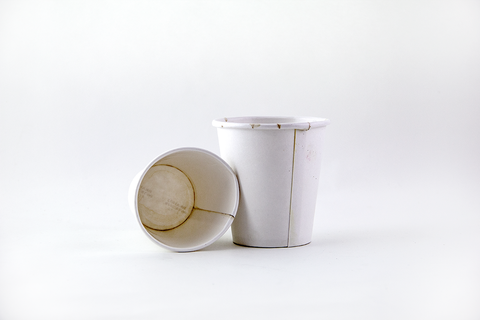Underneath a professional espresso machine
You first have to understand the mechanics of an espresso machine to clearly identify the sources of possible "problems" caused by its inactivity, says Pier-Paul Fortin of l’Atelier Espresso. Most commercial espresso machines operate with a heat exchanger system. This means that inside the machine there is a boiler (kettle). The function of this boiler is to maintain the water at a determined temperature and pressure in order to be able to supply steam almost continuously. Inside this boiler, there is a closed flue running through it. This duct is of a specific length and diameter to enable heat transfer from the boiler to the water inside the circuit. This is called the heat exchanger. This makes it possible to continuously supply heated water at a controlled temperature, almost infinitely.
Once we understand these principles, we can begin to identify the sources of problems caused by keeping the machine inactive for a long time. Each extraction leaves its share of oils and particles that stick to the filter, nozzle head and seals, and this residue is sometimes absorbed into the conduits. In addition to jeopardizing your machine’s proper functioning, poor maintenance can cause excess bitterness during extractions and a more rancid taste.
Don't worry about the boiler
Although the water will be stagnant in this part of the machine, it has been heated and pressurized above the boiling temperature. When restarting the machine it will do so again. The water was therefore previously pasteurized and will become so again, fairly quickly. A few seconds or even minutes are long enough to pasteurize the water at this temperature, says Pier-Paul.
The heat exchanger
Since this component holds a small amount of water, all you need to do is "purge" the water remaining in this part. To do so, just run water by activating the machine as if you wanted to make a coffee, so that the water flows from the group head.
Water filtration
The main source of problems will involve the water filtration system. The filter’s job is to create a barrier to impurities in order to provide better water quality. Impurities therefore accumulate in it day after day. The standing water inside is a fertile playground for bacteria, the accumulation of impurities, and it also decreases filtration efficiency (overload).
Solution: Since there are several different water filtration systems, you should know about yours and be sure to clean/replace the filtration media accordingly. It is essential to change it or have it changed before you restart your espresso machine to avoid ending up with lime build-up.
The mechanics of the commercial espresso machine
The sudden closure of restaurants, cafes and other businesses likely did not allow adequate time to clean the equipment properly. The machine itself is not at risk if your equipment has been kept in a heated room; if not, always have your equipment checked by a professional. On the other hand, the machine’s interior may need a little love after a long vacation. So here’s what to do to descale your professional espresso machine’s brew group and flow valve.
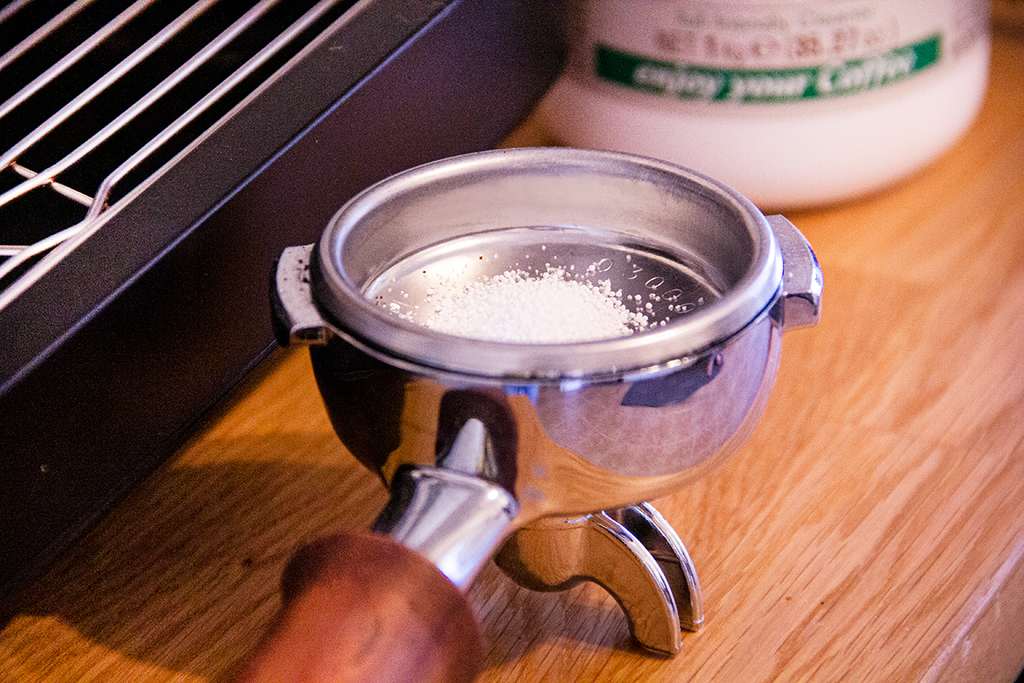
The group head
The backflush: A simple operation used to clean the ducts, i.e. the group depressurization valve. It is an outlet pipe for excess pressure, which enables you to clean the extraction system with a powerful water jet.- Place the blind filter (the one without the hole) into the filter holder. Put 5 grams of Puly Caff Verde detergent into the blind filter and place the filter holder into the machine group, activate the machine for 5-10 seconds and stop it. Wait 10 seconds.
- Repeat 4 machine activation cycles for 5-10 seconds with a 10-second pause between.
- Remove the filter holder, remove the blind filter and replace the regular filter.
- Run water through the group without the filter holder for 10 seconds.
This operation does 2 things:
- It cleans the part of the pipes from which the water exits to make coffee.
- It cleans the depressurization valve to prevent it from sticking and remaining in the open position, which will require a repair technician if so.
Should the filter holder be soaked in a solution?
The filter holder must absolutely be clean and contain no residue from the last extraction.
“Would you fry your eggs in the same dirty pan as the day before without washing it? NO. The same goes for the filter holder, otherwise your coffee will taste the one brewed before”, says Pier-Paul.
Immerse the filters and filter holders for 15 minutes into a solution containing 1 liter of very hot water mixed with 10g of Puly powder. Then rinse them with water.

Buy Puly Caff Verde
Milk pipe cleaning
In addition to cleaning the frother and milk jug on a daily basis, it is important to thoroughly clean the frother's drip drain. This step does not only clean it, but it improves deodorization and ensures the nozzle’s proper operation, eliminating any organic residue capable of causing malfunction, mould or unpleasant odours.Frequency of use
Use Puly Milk liquid to clean the steam nozzle and the milk tube approximately every 50 uses and whenever you need to return the machine to good working order, as in this case, after a long period of inactivity.
- Add 25 ml of Puly Milk to 500 ml of cold water: the blue section on the left is designed so that you can squeeze the bottle until the required amount enters the measuring container (0-30 ml) before opening and pouring.
- Insert the steam nozzle into the solution.
- Open and shut off the steam 7 to 10 times, which will cause suction.
- Open and shut off the steamer 3 times in cold clean water to ensure it is properly rinsed.
The grinder
Coffee contains oils that settle and accumulate in several places in the grinder. Over time, it will go rancid. It is therefore a good time to take advantage of the break to clean the grinders and remove oily deposits, mould or accumulation.
Empty the coffee bean container and pour in a package of Puly Grind Verde crystals.
- Grind the contents of the package with coffee beans.
- Once everything is ground, add coffee beans and discard the first two grinds.
Puly Grind easily cleans up oils or residues trapped between the grinder blades and prevents you from dismantling the grinders each time you clean them.
Cleaning frequency
As Pier-Paul Fortin, owner of l’Atelier Espresso explains, cleaning frequency is a polarizing topic within the industry. There are therefore as many recommendations as there are technicians. Here are his recommendations for all commercial machines in restaurants, cafes and others:
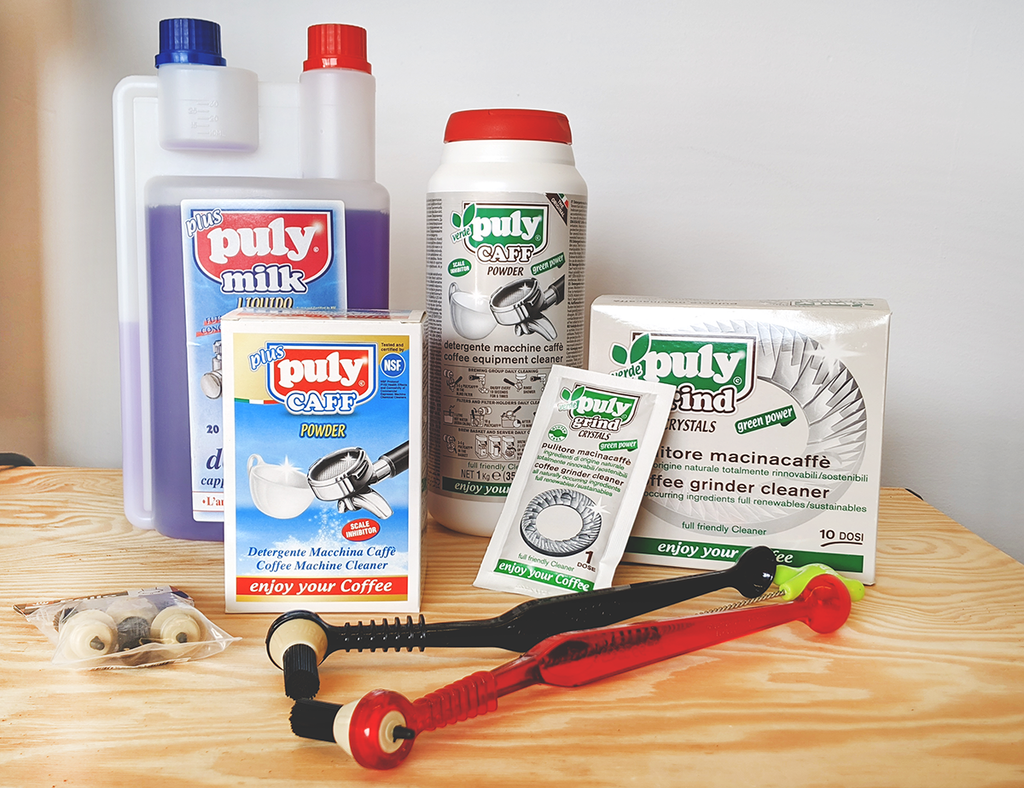
Commercial machines
Backflush EVERY day!!!! Do so before your establishment’s closing or during a period of low traffic. The amount of coffee made per day has less of an impact than the duration of downtime between each coffee made. It is during these periods that coffee residues can solidify and eventually create an obstruction.
Residential machines
Once a week and again, the number of coffees made per day doesn't matter. You must further adapt your cleaning behaviour based on the time during which your machine remains on without making coffee.Here is a reminder of the daily cleaning tasks for your espresso machine:
- Change the water filter
- Clean the group head
- Soak the filter holder
- Descale the milk pipes and the frother's drip drain
- Remove greasy deposits from the grinder
Have a great reopening!
]]>
Brewing more eco-friendly coffee doesn’t stop at buying fair-trade coffee. Did you know there are other ways to enjoying a “greener” cup of coffee? BeCoffee is pleased to announce that we’ve created a series of reusable coffee filters to drastically reduce waste from traditional coffee filters. These cotton coffee filters are available in both #4 and V60 sizes and Basket.
We created these reusable coffee filters in cooperation with artisans in Québec. They are an ecological alternative to coffee filters you have to throw out in the trash. Made from 100% organic cotton and organic thread, our coffee filters can be washed after each use and do not alter the taste of your coffee. Double-ply cotton also means that you don’t have to alter your brewing times and ensures that no residues or oils end up in your cup. The BeCoffee reusable coffee filter is faithful to the infusion time required according to good practices. We can see depend to the roasting a variation +/- 1 of the setting of the usual grind.
Why cotton coffee filters make sense

Instructions
- Rinse the filter with boiling hot water before use.
- Place the filter in your coffee machine’s basket and add freshly ground coffee in the filter. Enjoy your coffee!
- Get rid of the used coffee grounds; ideally, put them in your composting bin. Rinse the filter with hot water.
- Hang to dry until your next cup of coffee!
Caring for your organic coffee filter

If you forget your organic coffee filter for a few hours in your coffee machine, we recommend that you clean it thoroughly.
The colour and odor of your organic coffee filter is a good gauge as to when you should clean it. We suggest washing it once a week. All you have to do is soak it in a container with boiling water in order to eliminate residue and oils.
For a more thorough cleaning, add baking soda to the boiling hot water. Let it soak 10 minutes. Rinse completely before drying.
Shop Coffee Filters
]]>
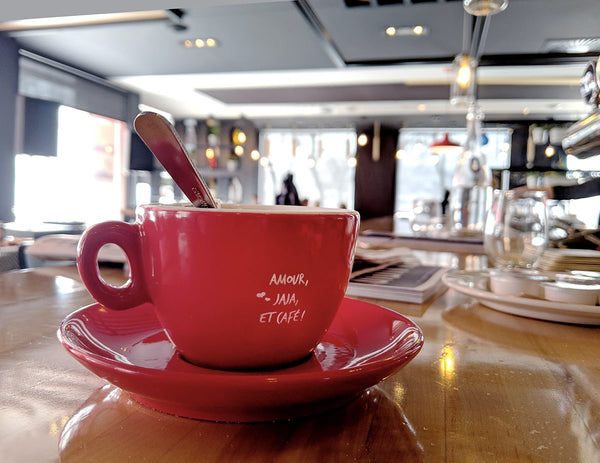
Your regular customers as well as new ones are part of your natural everyday ambassadors. That's why you would like to have a small part of yourself displayed with every cup of coffee to drink on the spot or to take away. The good news is that we can customize your coffee accessories. From the Inker coffee cup to the rCUP reusable coffee cup and barista aprons, we can affix your logo, corporate identity or message, and it will withstand washing.
Customization of coffee accessories at BeCoffee
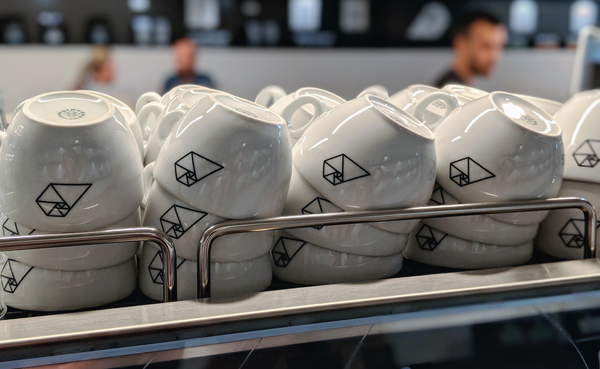
Feldspar's high composition rate, which, after the heating method, gives the Inker cup its vitrified finish and commercial grade quality, requires customization that resists commercial washing. For this reason, we prefer to use pad printing to affix logos. This process, which is done manually, ensures that your corporate identity will be as resistant as your cups.
“At Structure Torréfacteur, our approach is to reveal the work of the producers. We believe that coffee gains its character on the farm. That's why our roasting is designed to preserve these flavours. It is important for us to present their work in a cup that enhances this tasting experience. That's why we chose Inker coffee cups.”
Marco Dieckmann, Co-owner - Director of Development and Marketing at Structure Torréfacteur
For the reusable rCUP coffee cup, we had to identify the right combination of pad printing and ink, as it is made from recycled paper cups. We have succeeded in achieving this. Of course, we are always looking for the greenest products possible to customize, although for the moment, it is not yet possible to find any.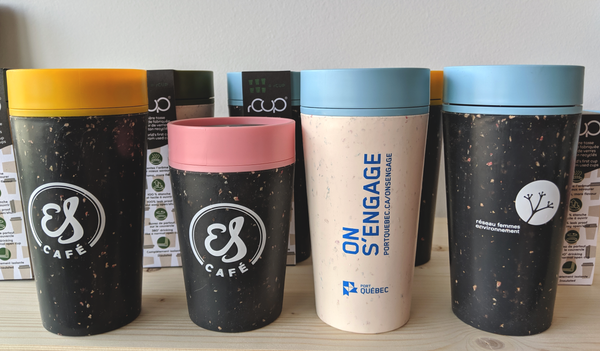
Why pad printing? Because screen printing does not adhere well and laser engraving damages the materials, thus reducing the strength and durability of the cup. Pad printing also makes it possible to print well on curved shapes with precision.
“An rCUP coffee cup was distributed to all employees, who immediately adopted it because of its innovative and robust design! In addition to being environmentally friendly, it is very convenient for both office and field employees.”
Julie Turmel, Communications Officer, Port of Québec
Customization time
As soon as you have confirmed an order for coffee accessories with us, we offer you, free of charge, the positioning of your logo or text on the cup. Once the model is approved, it takes about 10 business days to customize. This time is necessary to ensure production, handling (because each cup is pad-printed manually), and above all an optimal drying time. Otherwise, your customization will not be as resistant.

Customization beyond the logo
BeCoffee always wants to meet your needs as accurately as possible. So we offer three forms of customization for your coffee accessories:
- Logo printing - illustrations - text - on one or both sides, in one or four colours, on the walls of the coffee cup or reusable coffee cup
- Inker or rCUP coffee cups can be customised according to your pantone colour or for complete customised packaging (from a minimum quantity)
- Embroidery on apron;
- Hitting boxes for filter holders and coffee presses with your logo
- Any other custom request

“I really like Inker coffee cups because they stand out. They are resistant and do not stain. With the old cup models, we had to soak them every week. But with Inker cups, no need, they are sparkling at all times.”
Josée Potvin, Partner and Director of Operations, Groupe Restos Plaisirs
If you would like to request a quote for customization, please email us at [email protected]
]]>In the world of sport, it is not uncommon to see athletes consuming coffee, caffeinated beverages or pre-workout supplements before training or competition. In fact, some studies have demonstrated caffeine’s benefits on sports performance. But does caffeine improve performance for all athletes? And how exactly does it work? Are there any side effects? What are the specific recommendations? Here is an overview about caffeine’s impact on athletes!
Positive effects of caffeine on athletic performance
According to several scientific studies, coffee and caffeine have a performance-enhancing effect on muscular activity, which results in improved athletic performance. This effect is observed, in particular, during long endurance exercises such as running.
According to a study of cyclists, they achieved better performance in terms of speed and power after a caffeine dose of 5 milligrams (mg) per kilogram (kg) of body weight taken 60 minutes before exercise, compared to cyclists who had not consumed it. The results of 12 different studies on the subject also show that athletic performance improves by an average of 3% with caffeine intake and that reflexes, motor coordination and concentration are also optimized.
How does caffeine work?
Caffeine acts primarily on the nervous system. Among other things, caffeine competes with adenosine, stimulates adrenaline secretion, increases the cellular secretion of ions and reduces feelings of pain and fatigue during exertion.
“Did you know that between 1984 and 2004, Olympians with a high concentration of caffeine in their blood (higher than 12 μg/ml of blood (or the equivalent of about 8 shots of espresso in a few hours) were banned from Olympic events by the World Anti-Doping Agency?”
What about dehydration?
Have you ever heard that coffee dehydrates? Should it be avoided during intense physical activity that causes sweating? After all, we do want to maintain our fluids, at all costs. Well, this myth is simply not true. Caffeine contained in coffee and tea has no diuretic effect when consumption remains under 225 mg of caffeine per day. In addition, even with consumption greater than 225 mg, the amount of liquid ingested remains higher than the amount lost in the urine. Thus, whether consumed in small or large quantities, drinking coffee does not cause dehydration!Possible side effects
- Drinking coffee before exercise is not recommended for everyone. In fact, some individuals will react very positively to the effects of caffeine while others will be more sensitive. Some suffer from insomnia before competitions or notice an increase in the urge to urinate, while others experience palpitations, nausea, headaches or even anxiety;
- Also, for those already suffering from gastric reflux, ingesting caffeine during physical activity can greatly exacerbate the symptoms;
- Lastly, one of the most frequently experienced side effects is diarrhea, which in most cases is accompanied by abdominal cramps. This can occur both during and after physical activity.
 Photo: Cafe Hubert Saint-Jean
Photo: Cafe Hubert Saint-Jean
Individual tolerance
Individual tolerance depends on several factors, including genetics (the CYP1A2 gene alone is responsible for 95% of caffeine metabolism), your gender, age, the time of day, your caffeine consumption habits, whether you use of alcohol and tobacco, oral contraceptives or other medications, whether you are pregnant, breastfeeding, or experiencing a menstrual cycle, your physical fitness, and the method of administration.
In short, you may experience some or more benefits or side effects depending on all of these factors. For example, those carrying a mutation of the CYP1A2 gene (genotype AA) may gain an advantage in sports competitions. A 2018 scientific study published in the journal Medicine & Science in Sports & Exercise reports that ingesting 2 to 4 mg of caffeine per kg of body weight improved performance during a 10 km cycling trip (4.8% faster at 2 mg/kg and 6.8% at 4 mg/kg), whereas a neutral effect was reported for AC genotypes, an performance actually decreased (13.7% slower) for those in the CC group.
Recommendations
According to science, caffeine takes about 15 minutes to enter the bloodstream after being ingested. However, its full effects reach their peak about one hour after consumption. Therefore, a dose of 3 to 9 mg of caffeine per kg of body weight is recommended approximately one hour before exercise, for optimal results. But be careful! Caffeine’s effects can still be felt 3 to 4 hours after consuming it and Health Canada recommends not exceeding 400 mg of caffeine per day.
Enjoy your coffee!
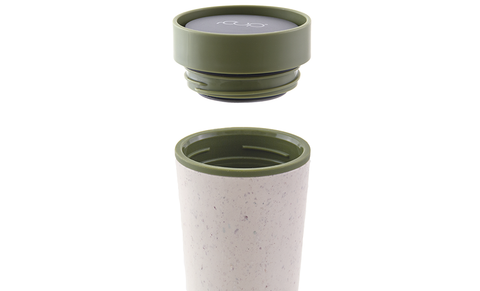
By adopting rCUP, you save from throwing away more than 350 cups from landfill and contribute directly to the recycling of used cups. In each 8 oz rCUP, 4 disposable cups are recycled and it goes to 6 for the 12 oz.
The rCUP is made from 40% recycled content with the outer thermal layer being 30% cups and 70% recycled polymer, sourced from used lids and plastic cups. The remaining 60% is made from virgin plastic, due to food safety requirements.
Ashortwalk, together with their partners, is in the process of developing a food-grade recycled PP polymer, and they hope to implement this into production by mid-2019. This would be another world’s first.
The main advantages of the rCUP:
- Made of 40% recycled materials
- Fully insulated
- Full aroma for more flavor
- 360 degres drinking like a normal open cup
- Easy to open/shut
- 100% leak proof
- 100% recyclable ans BPA Free
- Can be customized with logo
- Dishwasher safe

In most cases your rCUP will keep your drink warm for over 90 minutes - plenty of time, even for the most slow-supping coffee drinker. And generally speaking we found that rCUP loses about 10 ̊C of heat for every 30 minutes. Because rCUP is so easy to open and close - just pop – you should always keep your rCUP shut when you’re not drinking, to help your drink stay warmer for that little bit longer.

The rCUP is designed for about ten years use.
Take the opportunity to get yours, free shipping with the purchase of two rCUP with the discount code RCUPFOR2.
]]>It’s much more than a question of design!
How does it feel in your hand?
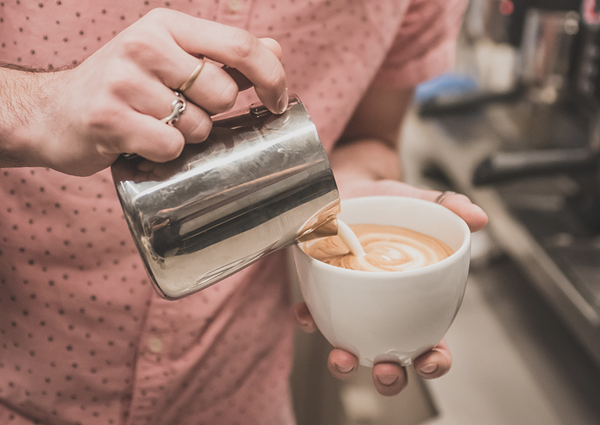
Whether at home or in an establishment, nothing is more unpleasant than getting a cup you can’t hold in your hands. A cup that is too hot indicates one thing: it absorbs heat rather than keeping it in the liquid. A cup that absorbs a lot of heat is usually a sign of a product whose component materials contain substituents, most commonly bone ash. Clay-like minerals such as hard porcelain provide far superior quality. Substituents are used to save costs and unfortunately, they are not free of any inconveniences. Most Quebec soil does not contain these minerals, and although our artisans are very talented, mugs made here usually carry this defect unless the clay was imported, which drives up prices considerably.
Vitrification versus glaze or varnish for repeated washings
The way the cup is finished has a major impact on its durability and longevity. Vitrification is a technique (in-glaze) in which the chemical result of heating the clay gives it a glossy appearance. It is a layer of glass that formed by chemical transformation and protects the porcelain from external elements like water, coffee acidity, cleaning, etc. A product that is made with the over-glaze method is preheated before applying any decoration (colour). It is then finished with a protective layer, often glaze or varnish. The issue with this second technique is that without vitrification, this layer will eventually degrade from external elements, particularly after recurrent use and the thermal shock from a commercial high temperature dishwashing machine. With this type of cup, you will notice fine cracks, which inevitably lead to the porcelain being infiltrated. With water and coffee, the porcelain becomes gray, and these signs of wear after liquid infiltration is evidence of uncleanliness. As a result, it becomes more porous and breaks more easily, so consider the durability factor when choosing a cup.

In conclusion, a quality porcelain cup will improve the quality of your service, and it will be all the more durable over time if it is vitrified. And although getting custom printing on your cup has a negligible impact on its quality, it will adhere better and last longer.
Here is a comparisons table that shows how Inker coffee cups are best
Your reusable Frank Green stainless steel mug provides excellent insulating properties due to its double wall. It will keep your drink hot for up to 10 hours. Its screw cap and smart, one-handed push button prevent leaks. It is stain- and odour-resistant, so you'll taste your coffee, not your cup. What’s more: you’ll help to reduce the waste generated by disposable paper cups. All models are also recyclable at the end of their useful life.
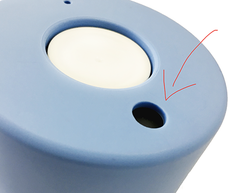
Did you know that the lid opening is designed to provide optimal liquid flow?
How to assemble the Frank Green cup’s lid parts after fully cleaning them
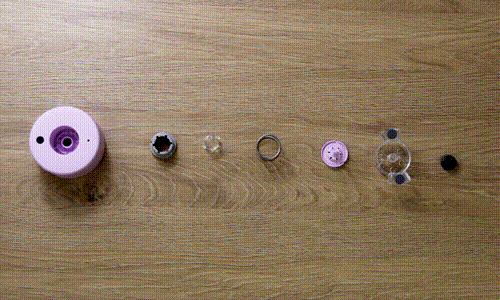
Steps to follow:
- Insert the small slotted gray circle that fits into the lid.
- Insert the small, transparent wheel into the slots of the gray circle.
- Insert the spring over the previous parts.
- Insert the button into the centre.
- Turn the lid over and affix the flow adjuster to make the cup watertight. Be sure to position the two gray dots opposite the two small circles.
- Screw everything together while holding the pieces in place, but without forcing it.
A portable coffee cup, and more!
In addition to being a portable hot or cold beverage cup, you need to know how to get the most from your Frank Green reusable cup.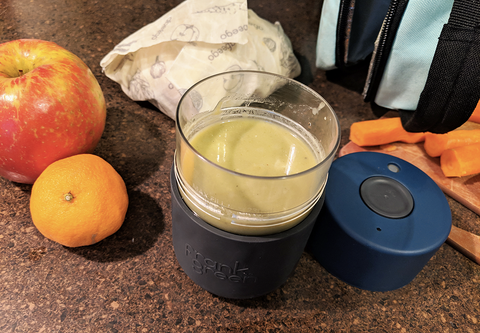
- The Original model can be used as a soup thermos for children at school, as the recycled plastic cup, without the lid, is microwave-safe.
- The cup is great for bringing hot chocolate on family ski outings.
-
The stainless-steel model is perfect for tea, with its small inner container or to filter any seeds or ice cubes from your cold drink. Yes, it keeps drinks just as cold as it does hot!
Here’s a little tip: Pour boiling water into the cup and let it sit for a few minutes to warm the walls before you put your hot coffee in it. Its insulating power will be even more effective.
More information about Frank Green here
Purchase our cups with groups of friends or co-workers, because:
🚚 Delivery is free when you purchase 2 or more✌🏼
Customized Frank Green cups
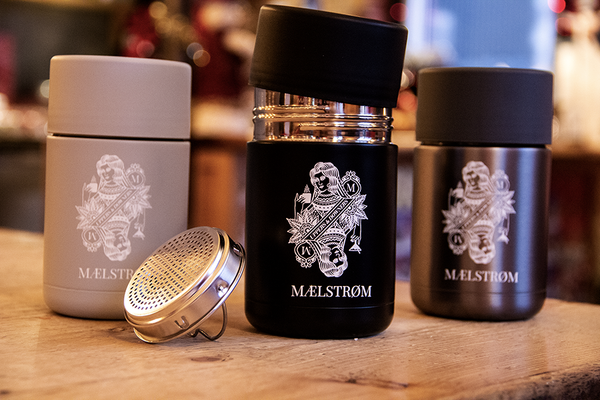
If you’d like your company logo, an illustration or a kind word printed on your cup, we can customize them as you like. Feel free to contact us about your custom cup needs at
Still not finished buying all your gifts? Here are a few very unique caffeinated ideas sure to delight.
Quality wooden coffee press made in Québec
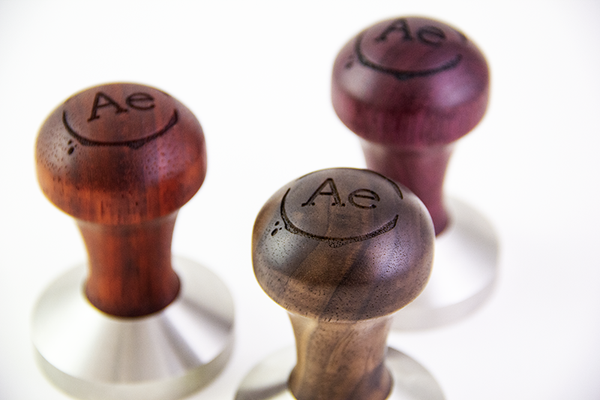
Prepare your espresso in complete nobility with a Tamper from Atelier Espresso. They are fully designed and handcrafted in Québec from wood species indigenous to the region and some eco-responsible imports.
View Coffee Tampers
Milan – Barista Apron

The unisex Patrizio apron is equipped with a system of removable metal clip fasteners and is perfect for the home or professional Barista. It is meticulously handcrafted in Canada from quality materials, including fire-resistant fabric and washable natural leather straps.
Choose an apron design
KAYÉ – Coffee tasting journal

Does your spouse or friend savour coffee just like a great wine, but can never remember the roast? Buy your loved ones an FSC-certified recycled paper coffee tasting journal made in Montréal.
Buy a tasting coffees notebook

The leading BeCoffee product, 100% Québec-made, reusable #4 and V60 coffee filters are an ecological alternative to disposable filters commonly used in manual infusion. Made from unbleached natural cotton, they are washable and can be reused without affecting the taste. Their double thickness ensures an infusion time comparable to paper filters and leaves no residue or oil in your cup. They are available with different colours of stitching, including red, black, orange and green.
Buy a coffee filter
Exclusives coffee products made outside of Québec
The Brewista Artisan kettle
The variable control Brewista Artisan kettle combines both the elegance of wood and digital precision. It has an ergonomically designed handle for better comfort. The kettle can be programmed to start automatically, such as in the morning, so that the water is at the right temperature when the alarm clock rings. Its auto power-off function provides protection when the unit is idle for more than 60 minutes. It also keeps water hot for up to an hour.
Buy a Brewista kettle

Why not give the gift of a reusable thermos mug from Frank Green to keep beverages hot and promote responsible coffee consumption? It is available in 8-20 ounce sizes and a variety of colours.
Buy a reusable cup
We can’t ignore our four favourites, with or without caffeine:
- The Lichée Cold Brew Caramel, made with the Structure Coffee Roaster, is simply awesome! You’ll struggle to keep the lid closed after you taste it!

- Hand-illustrated greeting cards made by Sara Pruneau Bélanger for coffee lovers.
- Dark-chocolate-dipped coffee beans from Chocolats Favoris.
- The Hubert Cormier health calendar, which provides 12 salad recipes made with seasonal ingredients for your enjoyment throughout the year.

You can buy BeCoffee products online or visit our boutique in Québec City, located at 1375 rue Frank-Carrel, Door 30.
Happy Holidays!
]]>
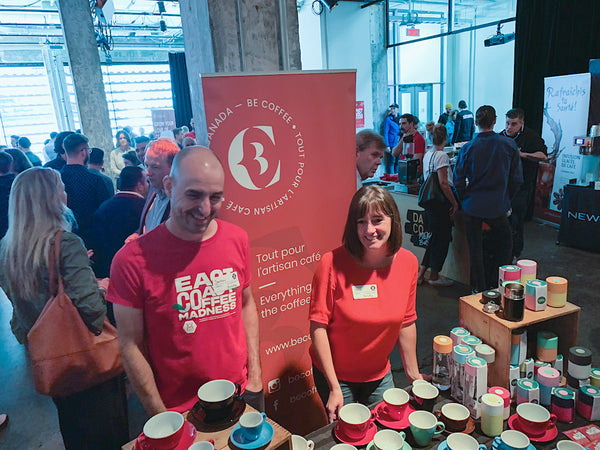
Photo credit : DKPhoto.co
For our first event, we did not know what to expect, being the new kids on the block. We were completely stunned by the popularity of FrankGreen's reusable mug, our organic cotton filters and the Inker coffee mugs we were launching at the event. From the first morning brew, we realized that it was more than relevant for BeCoffee to be present at this 4th edition of the event. It is difficult for us to comment on the conferences since our booth was swarmed by people.

Photo credit : DKPhoto.co
However, we can certainly comment on the responsiveness of the participants. For attendees who operated both starter cafés and the well-established ones alike, their enthusiasm was palpable. Even some coffee growers were sensitive to the quality of our products that greeted their beens. Many café owners and baristas took the time to discover our products and share their realities and challenges.
We must also highlight the strong interest of Bianca Lavoie, Co-founder of the event and Director of Communications, who wanted to welcome businesses from Québec City. This greatly motivated our decision to attend the event. According to Bianca:
"East Coast Coffee Madness was created not only to bring together the specialty coffee community in Montréal but also to promote its local artisans and demonstrate that the independent coffee scene on the east coast is alive and well. If we simply take the province of Québec, it is wrong to claim that everything is happening in Montréal, even though we have a larger and denser pool of cafes and specialty roasters than other regions of Québec. There are many other quality suppliers in the province. There should be no borders, per se, when it comes to coffee. After all, coffee is what brings people together. Inclusiveness, in a broader sense, is important to us.
BeCoffee, a company in Québec City, is an excellent example of the quality and authenticity we foster at our event. The team is completely aligned with our mission and vision. Even though I have known them for years, I found it important to contact them again this year to introduce the idea of participating at ECCM to allow them to share their products with amateur and professional coffee lovers who hail from both here and from abroad. There is a great coffee scene in Québec City and I have been following the BeCoffee team since the business was founded.”

Pursuing the common goal of growing the specialty coffee community, the ECCM, with its roundtable discussions, conferences, exhibitors, attendees and amazing volunteers, was an event rich with flavors and discoveries for BeCoffee. We met so many passionate and motivated people who are thrilled about sharing their knowledge about coffee.
The BeCoffee team would also like to give a shout out to the friendly Bradley of PropellerCoffee, Structure Roaster for its delicious coffee, Pilot and its Cold Brew latte and our FrankGreen ambassador, Gaya Lio, from ImpactKitchen.
]]>
Conquis dès le déballage
Il faut se le dire : l’emballage fait partie de l’expérience d’achat, et Comandante l’a bien compris. Chaque pièce est disposée individuellement dans un compartiment, la partie qui comprend les meules étant soigneusement emballée. On retire chaque pièce l’une après l’autre avec excitement. Une petite note y repose, indiquant qui a inspecté la machine avant qu’elle soit scellée dans son emballage.
Look et finition de qualité supérieure

Rien de grossier sur ce moulin, les extrémités des parois sont soigneusement arrondies. La tête de manivelle s’insère facilement et solidement dans son embout, laissant place à un mouvement fluide et sans friction avec le mécanisme. Son boîtier avec recouvrement en bois lui confère un look haut de gamme. Ses réceptacles en verre (un translucide et un opaque) sont épais et résistants. Ils ont la taille parfaite pour transverser au porte-filtre (panier 58 mm) sans dégâts
Les lames nitro, de vrais rasoirs

On sent bien que les lames n’écrasent pas les grains, qu’elles les découpent avec une facilité déconcertante. Il en résulte une mouture surprenamment très homogène. Nul besoin d’appliquer beaucoup de force sur la manivelle, on sent bien que ce sont les lames qui se chargent du travail. Par le fait même, l’empreinte sonore en est considérablement réduite, pour le plaisir de vos oreilles et pour un peu plus de discrétion si vous êtes le matinal de la maisonnée.
Finalement, on peut affirmer que le Comandante C40 Nitro Blade est la Mercedes-Benz des moulins manuels. Son prix peut en rebuter plus d’un, mais la qualité du produit en vaut grandement la chandelle pour ceux qui cherchent un moulin manuel portable professionnel.
On aime :
- La fluidité, qui réduit les efforts à la mouture
- Le son et la qualité de sa finition
- La présence de deux réceptacles (translucide et opaque)
On aurait aimé :
- Un indicateur gradateur de mouture (actuellement, il y a seulement une indication pour réduire ou grossir la mouture)
]]>
Vous vous êtes reconnu?
Voici donc 4 éléments essentiels à prendre en considération lorsque vous vous apprêtez à acheter un café dans votre établissement favori.
1. Différencier un mélange d’un café d’origine

Plusieurs cafés et torréfacteurs offrent ce que l’on appelle des blends, des mélanges de différents cafés. Ce n’est pas nécessairement une mauvaise chose, mais avant de savoir quel mélange vous va, il vous faut découvrir les subtilités des origines pour en reconnaître les goûts et arômes. Chaque pays producteur offre des caractéristiques bien propres à son terroir. Celles-ci sont influencées par une variété de facteurs : les plantations, le sol, l’ensoleillement, l’altitude, le procédé, etc. Comme pour le monde des vins, il faut découvrir les cépages, aussi influencés par des critères d’environnement, avant de savoir quel assemblage peut nous satisfaire. Généralement, un sac qui ne présente aucune origine a de forte chances d’être un mélange.
2. Définir son style avec les procédés de fermentation

Naturel, lavé, semi-lavé, hybride, etc. Il existe aussi une multitude de variétés de procédés. Si vous ne voulez pas vous attarder aux fins détails de ceux-ci (quoiqu’on vous y encourage!), vous pouvez tout de même reconnaître au minimum la différence de saveur typique entre un produit naturel et un produit lavé. Le naturel se reconnaît par un café qui a du corps, avec un large éventail de notes allant de l'acidité des caramboles au chocolat noir profond. Le procédé lavé, quant à lui, propose généralement un café plus léger et fruité. Encore une fois, un sac qui n’affiche pas le procédé contient fort probablement un mélange, dont la fraîcheur est fort probablement discutable. Les grains que vous retrouvez en épicerie, par exemple, peuvent rester sur les tablettes jusqu’à un an après leur torréfaction.
3. S’intéresser à la fraîcheur de la torréfaction
Un sac de café doit présenter la date de torréfaction du grain. L’établissement d’expertise reconnu L’Arbre à café recommande une consommation sous 90 jours suivant la torréfaction et propose 6 semaines pour une dégustation optimale. Pour de l’espresso, on parle de 2 à 5 semaines pour rester en zone optimale.
4. Privilégier les sacs aux silos

La café est un produit sensible à son environnement (oxygène, variation de température, lumière, humidité). L’exposition à la lumière – c’est souvent le cas dans une majorité d’établissements ayant des installations à silos – aura pour effet de précipiter la dégradation du grain. Ainsi, le sac demeure un meilleur choix puisqu’il limite l’exposition, les manipulations (lors de la récolte, de l’ensachage dans des sacs de jute, du processus de torréfaction et de la mise en sac) et les contacts du grain avec différentes surfaces. De plus, les sacs présentent souvent des fermetures et valves hermétiques. Vous aurez aussi compris que les silos fournissent rarement les informations sur les points précédents. Évitez donc les silos et conservez vos grains dans leur sac d’origine une fois à la maison.
Finalement, lors de votre prochaine visite, n’hésitez pas à poser vos questions. Bien que le personnel des établissements de café semble souvent très occupé par l’achalandage, les vrais passionnés prendront toujours le temps de vous informer pour trouver le produit qui pourrait répondre à votre besoin et à vos goûts. Nous vous encourageons aussi à découvrir cet univers qui a tant à proposer. Les habitudes de consommation du café spécialisé au Québec sont encore très jeunes, et nous avons la chance d’avoir des établissements proposant des produits exceptionnels.
Bonne découverte!

La fête des Pères arrive à grands pas (rappel: c’est le 18 juin!) et ce serait dommage de ne pas souligner, en cette journée qui leur est dédiée, l’amour que l’on a pour nos papas. Voici donc 5 idées cafés qui sauront plaire à celui que vous reconnaîtrez ci-dessous.
Parce que papa n’utilise pas une machine automatique qui fait le travail à sa place, il mout son café à la main à la perfection.

Le moulin à grains manuel Comandante C-40 Nitro Blade
Le meilleur moulin à grains manuel jamais conçu. Robustesse et haute précision caractérisent le Comandante C-40 Nitro Blade. La géométrie raffinée et la structure de la tête permettent d'atteindre les meilleures performances qui soient pour une distribution de particule de gains moulus parfaite. Fabriqué à la main en Allemagne.
Parce que papa aime passer du temps au chalet, en randonnée, en camping ou à la pêche.

L'ensemble AeroPress est un nouveau type de presse café qui produit le café dans des conditions idéales: température adéquate, immersion totale et filtrage rapide. Il vous permet de conserver tous les arômes de café frais en éliminant toute amertume et laissant seulement une belle nuance d'acidité.
Parce que papa accorde une importance à son look dans tout ce qu’il fait.

Le tablier barista Milan marine
Le tablier unisexe Patrizio marine est muni d'un système d'attache amovible avec pinces de métal. Fait à la main au Canada, pour une confection solide et d'une qualité inégalée
Parce que papa à de la classe quand il boit son café.

Le bol à latté Inker 9 onces noir
Solide et résistante, la demi-tasse est idéale pour les amateurs de latte et de chocolat chaud. De désign européen elle est reconnue pour sa qualité et son élégance. L’utilisation de matériaux de haute qualité assure sa longévité
Parce que papa n’a pas toujours le temps de finir son café avant de partir.

La KeepCup Brew Saffron édition Cork
Fabriqué en verre trempé, la tasse réutilisable KeepCup Brew édition Cork Saffron comporte une bande de liège naturel, un couvercle de couleur jaune et un bouchon pêche. Le liège utilisé est produit de rebut de la fabrication de bouchons de vin recyclables du Portugal.
Bonne fête des Pères!
]]>
Le café a généralement une place privilégiée dans la vie et le coeur d’une maman. Quand on y pense, c’est souvent la première chose qu’elle fait, le premier liquide qu’elle boit, le matin lorsqu’elle se lève tôt avant tout le monde. Et lorsque le sommeil n’est pas au rendez-vous, c’est souvent ce même liquide qui l’accompagne à travers sa journée. En fait, nous allons vous révéler un secret. Le café, c’est la potion magique qui fait que maman a une énergie qui lui donne cette allure surhumaine. Voici donc 5 idées cadeaux qui feront le plaisir des mamans. Commandez d’ici mercredi minuit pour vous assurer une livraison avant le weekend.
 La KeepCup Brew Edition Cork Fika
La KeepCup Brew Edition Cork Fika
Son look épuré et tendance ainsi que son bandeau en liège en fera son meilleur compagnon tout au long de sa journée. Résistante aux lave-vaisselles (sans le bandeau et sur le panier du haut), son bandeau est fait de liège recyclé de bouchon de vin du Portugal en plus d’être biodégradable. Un choix pratique et écologique!
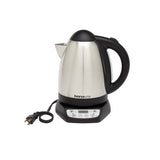 La bouilloire électrique à température variable Bonavita
La bouilloire électrique à température variable Bonavita
Parce qu’il est temps de remplacer cette vieille bouilloire par un peu plus de modernisme. La Bonavita électrique à température variable de 1.7 Litre a les attributs pour plaire. En plus des réglages de température, elle est conçue sur pivot central et permet la mise en veille automatique. Seul le socle présente un fil, la bouilloire pouvant être utilisée indépendamment.
Ce format bol a non seulement les meilleures propriétés des produits Inker, mais il a de plus le format qui rendra maman heureuse lorsqu’elle y apposera ses deux mains pour les réchauffer.
Maman a habitude à prendre un “bodum” ou un bon vieux filtre? Non seulement elle dira adieu aux résidus occasionnés par le piston, mais l’Aeropress est un petit bijou pour le camping ou le chalet.
 Le Chemex Classique série 10 tasses avec col en bois
Le Chemex Classique série 10 tasses avec col en bois
En plus d’être un instrument d’infusion pleine immersion de qualité, le Chemex a un look qui plaît pour le service à café. Il permet de réfrigérer et de réchauffer le café sans altérer son goût par sa fabrication en verre Borosilicate non poreux qui n'absorbe pas les odeurs et les résidus chimiques.
On vous souhaite une bonne fêtes des Mères!
]]>Here is a comparisons table that shows how Inker coffee cups are best:
|
Specs/Brands |
Inker |
England Product |
China Product |
|
Material |
Hard porcelain |
Ceramic |
Ceramic |
|
Water Absorption Rate |
< 0.01% |
> 0.2% |
> 0.5% |
|
Glaze Composition |
50% Kaolin 25% Feldspath |
40 to 50% Kaolin |
20 to 45% Bone Ash |
|
Hardness |
Very hard. Great abrasion resistance (8 Mohs) |
Hard. Good abrasion resistance. |
Soft. Low abrasion resistance. |
|
Colour |
White |
Cream |
Cream |
|
Lead Release |
Lead-free |
Could release lead |
Subject to more easily release lead |
|
Decoration |
Inglaze. Retains their brilliance permanently. |
Onglaze. Poor resistance to abrasion and chemicals. |
Onglaze. Poor resistance to abrasion and chemicals. |
|
Heat Resistance |
Microwave and dishwasher safe. |
Enamel is prone to cracking. |
Not recommended. |
|
Made in |
Croatia |
England |
China |
* Based on information available online.
Water Absorption Rate and Lead Release
Ceramic offers a higher water absorption rate than porcelain. This means that the residual porosity in ceramic products, caused by the use of bone hash and others materials, will alter the taste of the liquid that you pour in the cup.

Abrasion starting to slowly appear on made in China product
Hardness and Resistance
The purity and hardness level of Inker cups score 8 of 10 (10 is diamond). This is why Inker cups feature commercial-grade quality. Inevitably, commercial use is hard on dishware, due to repetitive dishwashing. However, Inker cups are the only ones that will not crack or appear altered over the time. They will remain brilliant forever!

Made in England product saucer showing marks of repetitive dishwashing
Decoration and Colours
The difference between inglaze and onglaze is quite important. With inglaze decorations, elements are applied over the top of the unfired glaze. During the firing process, they sink into and become part of the glaze. Onglaze, also known as overglaze and onglaze enamel, is used to decorate already glazed and fired surfaces. Onglaze decorations can have poor resistance to abrasion and chemical impacts.
Genuine European Quality and Design
Inker cups are leading the market with their exceptional durability and stylish European design. It’s the best product for commercial use or for consumers who want to make their home coffee ritual a perfect moment.
Now that you are convinced of the benefits of Inker cups, take a look at our inventory!
]]>

Vous souhaitez faire plaisir à un être cher qui se passionne pour le café ? Voici un petit guide présentant 10 produits qui sont tendances et qui sauront les satisfaire. Nous les avons regroupés en 3 catégories, de l’amoureux du rituel café, du geek de café, à l’apprenti barista. Ces suggestions sont pour toutes les bourses, proposant des articles se détaillant de 4,95 $ à 89,95 $
Pour l’amoureux du rituel café
Voici trois valeurs sûres qui rendront heureux tout amateur de café. Ces produits sont tout indiqués pour une utilisation régulière, notamment pour le service et le transport.
Ensemble de démarrage cappuccino
 Idéal pour celui qui a reçu ou recevra une machine espresso! Notre ensemble de démarrage cappuccino comprend 2 demi-tasses Inker 6 onces en porcelaine de grade commercial, choix de couleur rouge ou blanche, un pichet latte art de 12 ou 20 onces et un thermomètre à lait 5 pouces tous deux de marque Rattleware.
Idéal pour celui qui a reçu ou recevra une machine espresso! Notre ensemble de démarrage cappuccino comprend 2 demi-tasses Inker 6 onces en porcelaine de grade commercial, choix de couleur rouge ou blanche, un pichet latte art de 12 ou 20 onces et un thermomètre à lait 5 pouces tous deux de marque Rattleware.
> À partir de 48.95$
KeepCup Brew Cork format 8 onces
 En plus de joindre le mouvement de la réutilisation des contenants de café, le KeepCup Brew Cork est un des modèles les plus prisés de la gamme Brew. Sa tasse est solide, en verre trempé, et présente une bande de liège naturel recyclée et biodégradable.
En plus de joindre le mouvement de la réutilisation des contenants de café, le KeepCup Brew Cork est un des modèles les plus prisés de la gamme Brew. Sa tasse est solide, en verre trempé, et présente une bande de liège naturel recyclée et biodégradable.
> Acheter pour 31.90$
Chemex Classique 10 tasses avec col en bois
 Fait de verre aux propriétés non poreuses, sa forme conique permet l’utilisation de filtre pour une infusion directe à même son contenant. Son col en bois assure un service vous évitant le contact avec la chaleur de son contenu tout en lui procurant une élégance remarquée comme contenant de service. Le Chemex est conçu pour réfrigérer et réchauffer le café sans en altérer son goût.
Fait de verre aux propriétés non poreuses, sa forme conique permet l’utilisation de filtre pour une infusion directe à même son contenant. Son col en bois assure un service vous évitant le contact avec la chaleur de son contenu tout en lui procurant une élégance remarquée comme contenant de service. Le Chemex est conçu pour réfrigérer et réchauffer le café sans en altérer son goût.
> Acheter pour 46.95$
Pour le geek de café
La préparation manuelle a la cote. Le café filtre effectue un retour en force pour les caféinomanes s’intéressant à toutes les facettes du goût, cette méthode lui laissant toute la place.
Ensemble Aeropress
 L’ensemble Aeropress est le compagnon idéal du geek de café. Il permet la confection du café dans les meilleures conditions, que ce soit pour utiliser à la maison, en camping ou en voyage.
L’ensemble Aeropress est le compagnon idéal du geek de café. Il permet la confection du café dans les meilleures conditions, que ce soit pour utiliser à la maison, en camping ou en voyage.
> 39.95$ au lieu de 41.95$
Moulin manuel Porlex Mini
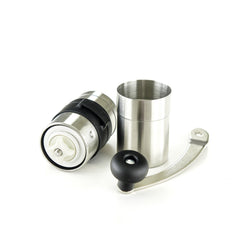 Parce qu’il n’y a rien de mieux qu’un café dont le grain est fraîchement moulu, le moulin manuel Porlex Mini est l’alternative abordable au moulin électrique automatique, généralement coûteux et demandant entretien. Son réservoir vous permet de moudre 26g de grains de café entiers.
Parce qu’il n’y a rien de mieux qu’un café dont le grain est fraîchement moulu, le moulin manuel Porlex Mini est l’alternative abordable au moulin électrique automatique, généralement coûteux et demandant entretien. Son réservoir vous permet de moudre 26g de grains de café entiers.
> Acheter pour 68.75$
Infuseur type V en porcelaine pour filtre #4 de Bonavita
 L’infuseur de porcelaine pour filtre #4 est sans aucun doute un des accessoires ayant contribué au retour en force du café filtre. Son utilisation est facile tout comme son nettoyage.
L’infuseur de porcelaine pour filtre #4 est sans aucun doute un des accessoires ayant contribué au retour en force du café filtre. Son utilisation est facile tout comme son nettoyage.
> Acheter pour 24.95$
Journal de bord 33 Cups of Coffee
 Puisque les torréfacteurs sont maintenant légion, le journal de bord 33 Cups of Coffee permet de tenir l’inventaire des goûts et arômes des différents produits dégustés. Fait à partir de papier 100% recyclé, il est imprimé avec de l’ancre de soya cultivé sous le chaud soleil de Portland aux États-Unis.
Puisque les torréfacteurs sont maintenant légion, le journal de bord 33 Cups of Coffee permet de tenir l’inventaire des goûts et arômes des différents produits dégustés. Fait à partir de papier 100% recyclé, il est imprimé avec de l’ancre de soya cultivé sous le chaud soleil de Portland aux États-Unis.
> Acheter pour 4.95$
Pour l’apprenti barista
Pour devenir un bon barista, rien n’est laissé pour contre et chaque détail compte. De la précision millimétrique du presse café jusqu’au tablier, un barista accompli est un barista bien outillé.
Presse café par Atelier Espresso
 Offert en 5 essences de bois nobles (amarante, loupe de merisier, cerisier, noyer foncé et padouk), les presses café de l’Atelier Espresso sont des pièces uniques. Ceux-ci sont offerts dans les formats les plus courants, de 51mm à 58mm.
Offert en 5 essences de bois nobles (amarante, loupe de merisier, cerisier, noyer foncé et padouk), les presses café de l’Atelier Espresso sont des pièces uniques. Ceux-ci sont offerts dans les formats les plus courants, de 51mm à 58mm.
> À partir de 60$
Tablier barista par Milano
 Un bon café nécessite plusieurs manipulations, passant par une mouture fine jusqu’à la confection d’une mousse à lait parfaite pouvant laisser des traces. Les tabliers Milano sont conçus spécialement pour offrir une protection qui ne délaisse en rien le design tout en proposant un nettoyage facile.
Un bon café nécessite plusieurs manipulations, passant par une mouture fine jusqu’à la confection d’une mousse à lait parfaite pouvant laisser des traces. Les tabliers Milano sont conçus spécialement pour offrir une protection qui ne délaisse en rien le design tout en proposant un nettoyage facile.
> À partir de 48.95$ (quantité limitée)
Bac à résidus avec socle en métal
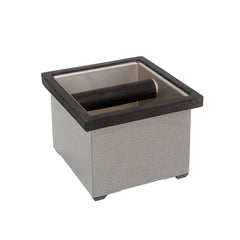 Disposer du marc de café peut s’avérer laborieux et salissant. Le bac à résidus avec socle de métal de Rattleware est le réceptacle idéal pour en disposer sans dégâts. Résistant, le bac est surmonté de 4 pattes en caoutchouc et son manchon du même matériel est remplaçable.
Disposer du marc de café peut s’avérer laborieux et salissant. Le bac à résidus avec socle de métal de Rattleware est le réceptacle idéal pour en disposer sans dégâts. Résistant, le bac est surmonté de 4 pattes en caoutchouc et son manchon du même matériel est remplaçable.
> Acheter pour 89.95$
Bonus!
Savon exfoliant au café par Rituels
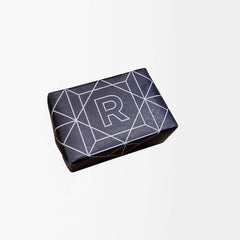 Créé et fabriqué au Québec exclusivement pour Rituels par la Savonnerie des Diligences, ce pain de savon de 130g et contient de l'huile d'olive, de noix de coco, de la cire d'abeille et des grains de café, ainsi que des huiles essentielles pour la fragrance. Idéal pour le bas de Noël de monsieur!
Créé et fabriqué au Québec exclusivement pour Rituels par la Savonnerie des Diligences, ce pain de savon de 130g et contient de l'huile d'olive, de noix de coco, de la cire d'abeille et des grains de café, ainsi que des huiles essentielles pour la fragrance. Idéal pour le bas de Noël de monsieur!
> Acheter pour 18.00$ sur Rituels.ca
]]>
Free Shipping
Canada and United States
For all order over 75$ CAD before taxes, you are eligible for free shipping for Canada and USA destinations.
Note that in the case of free shipping we reserve our entire discretion on the choice of delivery service provider.
Domestic Flat Rate Shipping
For orders to be delivered in Quebec and Ontario, you can now benefit from a fixed minimum rate of 7.95$.
Note that in the case of fixed rate shipping we reserve our entire discretion on the choice of delivery service provider.
Free Pickup in Store in Quebec City
If you are a resident of Quebec City or would like to go there to collect your purchase, you can choose the free picking option from the delivery alternatives offered.
If you choose this option, you must take into consideration that the recovery must be done from Monday to Friday from 8:30 to 12:00 and from 13:00 to 16:00. You must contact us at [email protected] to confirm the availability of your product to be recovered.
The address for picking is 1375 Rue Frank-Carrel, bureau 33, Quebec City, QC G1N 2E7
]]>
Consommateurs raffinés de café, vous disposez enfin d’une machine à espresso à la maison. Vous souhaitez réaliser un cappuccino avec une mousse de lait de qualité barista, mais vous arrivez à un résultat qui pourrait ressembler à votre première peinture à mains à l’âge de 2 ans? BeCoffee a rencontré pour vous Julie Audet, gérante du Café Saint-Henri de Québec et couronnée grande gagnante du Challenge Art Latte 2015, afin de vous offrir quelques trucs pour épater vos convives pendant les fêtes ou surprendre votre douce moitié.
Critères de base pour réussir un art latté
Bien avant l’aspect créatif, il faut savoir que l’objectif de l’art latté est de mettre en valeur une boisson composée de lait texturé et d’espresso, telle que le cappuccino et le latté. Sa réussite requiert un barista expérimenté, une machine à espresso de qualité ainsi qu’un respect de certains critères de base. Voici ceux qui, selon Julie, sont déterminants pour un art latté réussi :• Le type de lait
• La méthode de versage du lait dans l’espresso
• Le méthode de texturisation du lait
• Le format de la tasse et du pichet
Le lait
La qualité du lait est un critère important pour être en mesure de tirer le maximum du potentiel des matières grasses et des protéines, afin d’obtenir une boisson équilibrée. La quantité utilisée dépend du nombre de cafés que vous avez à faire, donc impossible de donner un chiffre absolu. Pour le choix du lait, Julie suggère d’opter pour du lait 3,25 % ou 3,8 %. Pourquoi 3,8 % ? En fait, il est possible de mousser le lait (et non l’eau) grâce à la présence des protéines : l’air introduit par la buse vapeur déstabilise ces protéines, qui forment ainsi une enveloppe protectrice et empêchent les bulles de disparaître. Alors pourquoi un lait plus gras? Les matières grasses sont responsables de la souplesse de cette mousse, ce côté lisse et malléable que nous recherchons. Plus il y a de gras, plus la mousse sera consistante, stable et souple, donc plus facile à manipuler pour l’art latté.
La température et la méthode de texturisation
Pour faciliter le moussage du lait, il est important de ne pas dépasser les deux tiers de la capacité maximale de votre pichet à lait. Julie suggère d’insérer la buse vapeur à la surface du lait au centre du pichet, afin de former un “tourbillon” lorsque la buse sera mise en fonction. Il est important de ne pas chauffer le lait à plus de 140 à 155 degrés Fahrenheit. À cette température, on obtient la concentration la plus élevée en sucre dans le lait. Le temps requis pour atteindre la bonne température dépend simplement de la puissance de la machine et de la quantité; on vous suggère d’ailleurs d’utiliser un thermomètre pour vous aider à vérifier la température du lait. Le mouvement de rotation permet de diminuer les bulles et de texturer afin d’avoir un résultat lisse.
Le format de tasse
Le format de la tasse n’a pas d’incidence sur le résultat final de la mousse, mais il est évident qu’une tasse trop profonde ou trop mince ne rendra pas justice à vos talents artistiques et refroidira votre café. Par ailleurs, pour exploiter le plein gout des grains et permettre à la mousse de lait d’habiller tout l’espace qui lui revient, les tasses à cappuccino de 5 à 7 oz sont excellentes, puisqu’elles offrent l’ouverture nécessaire, l’épaisseur pour conserver votre boisson chaude et la profondeur pour respecter les quantités d’espresso, de lait et de mousse de lait. 
Si vous avez la machine à la maison mais ne possédez pas les instruments pour respecter ces critères, nous avons bâti cet ensemble de départ incluant un pichet à art latté, un thermomètre et deux tasses à cappuccino reconnues pour la qualité et la résistance des matériaux.
Techniques de base de l’art latté à la maison
Il est possible d’utiliser deux techniques différentes pour le parfait art latté : le Free Pour, soit le versage libre de la mousse de lait sans instrument, et le Etching, c’est-à-dire la réalisation d’un visuel dans la mousse de lait avec un instrument. À moins que vous soyez un Picasso, nous allons nous concentrer pour débuter avec la technique de versage libre.
Trois figures de base peuvent être tentées pour cette oeuvre d’apprenti barista que vous souhaitez obtenir à la maison :
• Le coeur
• La rosetta
• La tulipe
Le coeur
Au début, on verse la mousse de lait en cercle dans le crema de l’espresso pour mieux intégrer le lait à l’espresso. Ensuite, on approche le bec du pichet près de la tasse. La raison en est fort simple : plus vous êtes loin, plus le lait pénètre dans le crema; plus vous êtes proche, plus la mousse de lait demeure en surface. Si vous inclinez un peu votre pichet, l’angle vous permettra un meilleur contrôle. Notez qu’un pichet avec un bec en V vous offrira plus de précision. De petits mouvements de zigzags ajoutent une autre dimension à votre coeur, puisqu’ils créent une multitude de lignes qui le composeront, comme s’il s’agissait de plusieurs coeurs l’un dans l’autre. Comme c’est romantique!
La tulipe
Pour la tulipe, on intègre le lait toujours en rotation au départ, mais on dépose ensuite de petites quantités de lait moussé que l’on pousse, sur la surface, à partir du haut du verre ou de la tasse, et l’on termine en faisant une ligne au-dessus de tout ça.
La rosetta
Une rosetta demande que le pichet soit près de votre crema et que l’on intègre le lait constamment en zigzaguant, par des mouvements de plus en plus rapprochés jusqu’à la fin, où l’on repasse en ligne droite sur nos traces.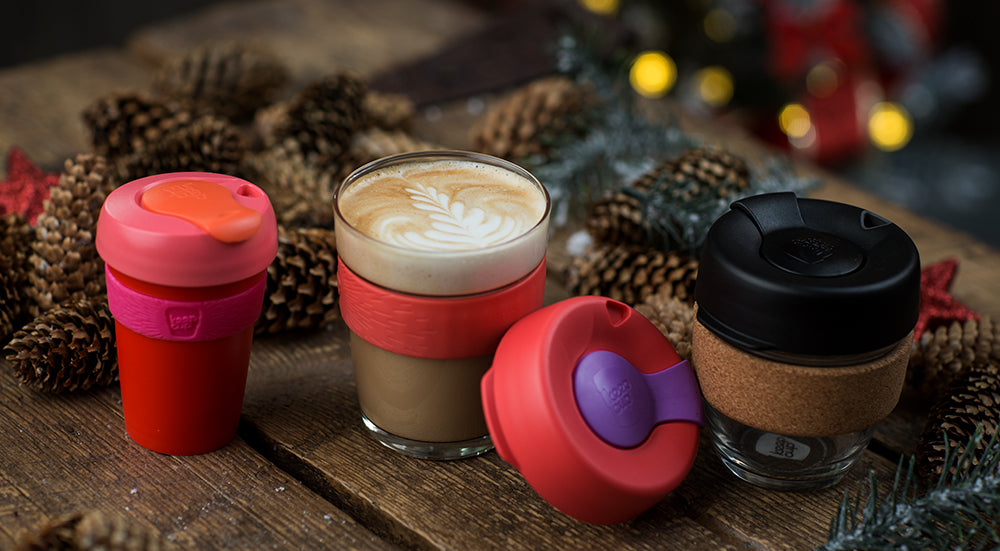
Si vous y prenez goût et souhaitez en apprendre davantage, Julie donne justement au Café Saint-Henri une formation Espresso à la maison+ Art Latté d’une durée de 3 h 30. Elle offre aussi la formation barista de l’École hôtelière de la Capitale, qui inclut, pour seulement 25 $, 7 cours de 3h chacun, destinés aux gens qui oeuvrent dans le domaine de la restauration. La prochaine session débutera le 16 janvier.
L’histoire d’une passionnée du café
Il y a 10 ans, Julie a quitté le Québec pour l’Australie, avide de découvertes et d’aventures. Alors à peine âgée de 18 ans, c’est sur la terre des kangourous qu’elle a gouté pour la première fois à des cafés aux goûts plus acidulés et floraux. Elle a rapidement développé un intérêt pour la tendance de 3e vague, déjà bien établie là-bas mais encore inconnue au Québec. On pourrait définir cette vague comme celle qui rassemble les amateurs de cafés raffinés qui reconnaissent le café comme un produit saisonnier de terroir et recherchent la subtilité des arômes dans des torréfactions légères à moyennes. La clientèle d’Australie étant très exigeante, Julie a tôt fait de compléter une formation de base au centre-ville de Sydney et après quelque temps, a pu devenir barista au café où elle travaillait.
À son retour au Québec, sa passion pour le café l’a vite rattrapée et elle a quitté les études pour se consacrer à un poste chez Les Brûleries, où elle veillait à l’ouverture de succursales, à apprendre les bases de la torréfaction, à monter et donner la formation sur le café aux employés et à assurer le contrôle qualité.
Souhaitant constamment enrichir ses connaissances sur le monde du café, elle a entre-temps suivi des formations chez Counter Culture Coffee à New York, visité des terres au Nicaragua pour comprendre la culture du grain ainsi que les méthodes d’achat et participé à un atelier sur la torréfaction avec nul autre que l’auteur et spécialiste du café Scott Rao.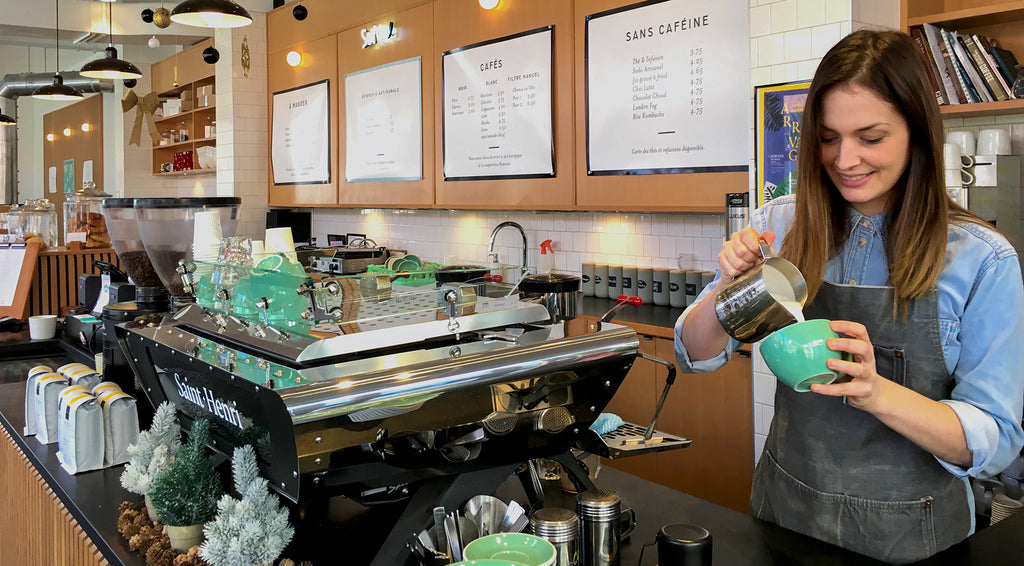
C’est en tant que juge au Championnat Barista de l’Est du Canada qu’elle a rencontré Jean-François Leduc, propriétaire du Café Saint-Henri à Montréal, qui était juge en chef de l’évènement. Ils sont devenus rapidement de bons contacts; Julie appréciait son approche axée sur le grain vert de qualité ainsi que sa volonté d’acheter directement des fermes. Ce partage de valeurs communes l’a donc poussée à joindre les rangs de l’équipe du Café Saint-Henri à Montréal. Dès ses débuts, elle a participé à la mise en scène du projet du Saint-Henri au Marché Jean-Talon, a survolé les départements de torréfaction, de formation des clients commerciaux et du contrôle de qualité. Étant originaire de Québec, c’est sans surprise qu’on lui ai confié l’ouverture du Saint-Henri de Québec. C’est avec des étoiles dans les yeux qu'elle nous explique que Jean-François a laissé beaucoup de place à ses idées et qu’ils ont bâti ensemble le café dont elle rêvait.
Au même moment, malgré sa nature plus réservée, elle a participé à sa première compétition et a été couronnée grande gagnante de la 1re édition du Challenge Art Latte Natrel.
C’est pendant l’été 2016 qu’elle a profité de son prix, qui était une formation d’une semaine au Japon avec Hidenori Izaki, champion mondial barista. Elle a, entre autres, survolé avec lui les étapes de préparation à un championnat barista et approfondi ses connaissances sur la qualité de l’eau pour extraire du café. Être en mesure de déterminer le gout qu’aura l’espresso tient beaucoup à la qualité de l’eau, donc son analyse est cruciale.
Vous pouvez croiser le joli sourire de Julie et profiter de son talent et de celui de ses collègues quotidiennement au Café Saint-Henri de Québec au 849 Saint-Joseph Est.
